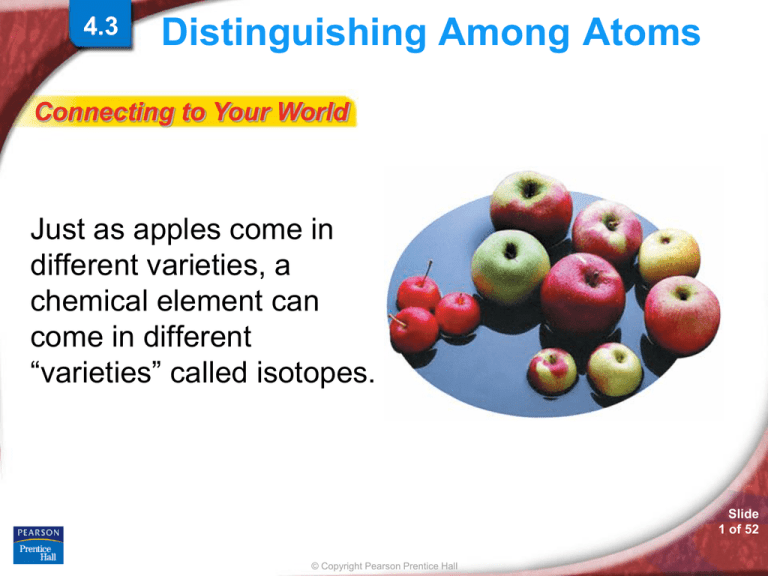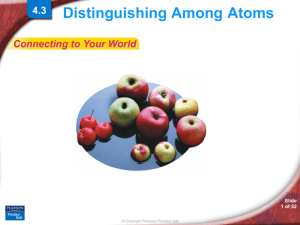
4.3
Distinguishing Among Atoms
Connecting to Your World
Just as apples come in
different varieties, a
chemical element can
come in different
“varieties” called isotopes.
Slide
1 of 52
© Copyright Pearson Prentice Hall
4.3
Distinguishing Among Atoms
>
Atomic Number
Atomic Number
What makes one element different from
another?
Slide
2 of 52
© Copyright Pearson Prentice Hall
4.3
Distinguishing Among Atoms
>
Atomic Number
Elements are different because they
contain different numbers of protons.
The atomic number of an element is the
number of protons in the nucleus of an atom
of that element.
Slide
3 of 52
© Copyright Pearson Prentice Hall
Slide
4 of 52
© Copyright Pearson Prentice Hall
Atomic Number
Slide
5 of 52
© Copyright Pearson Prentice Hall
Slide
6 of 52
© Copyright Pearson Prentice Hall
Practice Problems for Conceptual Problem 4.1
Problem Solving 4.15 Solve
Problem 15 with the help of an
interactive guided tutorial.
Slide
7 of 52
© Copyright Pearson Prentice Hall
4.3
Distinguishing Among Atoms
>
Mass Number
Mass Number
How do you find the number of neutrons
in an atom?
Slide
8 of 52
© Copyright Pearson Prentice Hall
4.3
Distinguishing Among Atoms
>
Mass Number
The total number of protons and neutrons in an
atom is called the mass number.
The number of neutrons in an atom is
the difference between the mass
number and atomic number.
Slide
9 of 52
© Copyright Pearson Prentice Hall
4.3
Distinguishing Among Atoms
>
Mass Number
Au is the chemical symbol for gold.
Slide
10 of 52
© Copyright Pearson Prentice Hall
SAMPLE PROBLEM 4.1
Slide
11 of 52
© Copyright Pearson Prentice Hall
Practice Problems for Sample Problem 4.1
Problem Solving 4.17 Solve
Problem 17 with the help of an
interactive guided tutorial.
Slide
12 of 52
© Copyright Pearson Prentice Hall
4.3
Distinguishing Among Atoms
>
Isotopes
Isotopes
How do isotopes of an element differ?
Slide
13 of 52
© Copyright Pearson Prentice Hall
4.3
Distinguishing Among Atoms
>
Isotopes
Isotopes are atoms that have the same number
of protons but different numbers of neutrons.
Because isotopes of an element have
different numbers of neutrons, they
also have different mass numbers.
Slide
14 of 52
© Copyright Pearson Prentice Hall
4.3
Distinguishing Among Atoms
>
Isotopes
Despite these differences, isotopes are
chemically alike because they have identical
numbers of protons and electrons.
Slide
15 of 52
© Copyright Pearson Prentice Hall
Slide
16 of 52
© Copyright Pearson Prentice Hall
Slide
17 of 52
© Copyright Pearson Prentice Hall
Slide
18 of 52
© Copyright Pearson Prentice Hall
Practice Problems for Conceptual Problem 4.2
Problem Solving 4.20
Solve Problem 20 with the help
of an interactive guided tutorial.
Slide
19 of 52
© Copyright Pearson Prentice Hall
4.3
Distinguishing Among Atoms
>
Atomic Mass
Atomic Mass
How do you calculate the atomic mass
of an element?
Slide
20 of 52
© Copyright Pearson Prentice Hall
4.3
Distinguishing Among Atoms
>
Atomic Mass
Measurement unit for Atomic mass = An atomic
mass unit (amu) is defined as one twelfth of the
mass of a carbon-12 atom.
Slide
21 of 52
© Copyright Pearson Prentice Hall
4.3
Distinguishing Among Atoms
>
Atomic Mass
The atomic mass of an element is a weighted
average mass of the atoms in a naturally
occurring sample of the element.
A weighted average mass reflects both the mass
and the relative abundance of the isotopes as
they occur in nature.
Slide
22 of 52
© Copyright Pearson Prentice Hall
Slide
23 of 52
© Copyright Pearson Prentice Hall
Slide
24 of 52
© Copyright Pearson Prentice Hall
Slide
25 of 52
© Copyright Pearson Prentice Hall
Practice Problems for Conceptual Problem 4.3
for Conceptual Problem 4.3
Problem Solving 4.21 Solve
Problem 21 with the help of
an interactive guided tutorial.
Slide
26 of 52
© Copyright Pearson Prentice Hall
4.3
Distinguishing Among Atoms
>
Atomic Mass
To calculate the atomic mass of an
element, multiply the mass of each
isotope by its natural abundance,
expressed as a decimal, and then add
the products.
Slide
27 of 52
© Copyright Pearson Prentice Hall
4.3
Distinguishing Among Atoms
>
Atomic Mass
For example, carbon has two stable isotopes:
• Carbon-12, which has a natural abundance of
98.89%, and
• Carbon-13, which has a natural abundance of
1.11%.
Slide
28 of 52
© Copyright Pearson Prentice Hall
SAMPLE PROBLEM 4.2
Slide
29 of 52
© Copyright Pearson Prentice Hall
SAMPLE PROBLEM 4.2
Slide
30 of 52
© Copyright Pearson Prentice Hall
SAMPLE PROBLEM 4.2
Slide
31 of 52
© Copyright Pearson Prentice Hall
SAMPLE PROBLEM 4.2
Slide
32 of 52
© Copyright Pearson Prentice Hall
Practice Problems for Sample Problem 4.2
Problem Solving 4.24 Solve
Problem 24 with the help of an
interactive guided tutorial.
Slide
33 of 52
© Copyright Pearson Prentice Hall
4.3
Distinguishing Among Atoms
>
The Periodic Table—A Preview
The Periodic Table—A Preview
Why is a periodic table useful?
Slide
34 of 52
© Copyright Pearson Prentice Hall
4.3
Distinguishing Among Atoms
>
The Periodic Table—A Preview
A periodic table is an arrangement of elements
in which the elements are separated into groups
based on a set of repeating properties.
A periodic table allows you to easily
compare the properties of one element
(or a group of elements) to another
element (or group of elements).
Slide
35 of 52
© Copyright Pearson Prentice Hall
4.3
Distinguishing Among Atoms
>
The Periodic Table—A Preview
The Periodic Table
Slide
36 of 52
© Copyright Pearson Prentice Hall
4.3
Distinguishing Among Atoms
>
The Periodic Table—A Preview
• Each horizontal row of the periodic table is
called a period.
• Within a given period, the properties of the
elements vary as you move across it from
element to element.
Slide
37 of 52
© Copyright Pearson Prentice Hall
4.3
Distinguishing Among Atoms
>
The Periodic Table—A Preview
A Period
Slide
38 of 52
© Copyright Pearson Prentice Hall
4.3
Distinguishing Among Atoms
>
The Periodic Table—A Preview
• Each vertical column of the periodic table is
called a group, or family.
• Elements within a group have similar chemical
and physical properties.
Slide
39 of 52
© Copyright Pearson Prentice Hall
4.3
Distinguishing Among Atoms
>
The Periodic Table—A Preview
A Group or Family
Slide
40 of 52
© Copyright Pearson Prentice Hall
4.3 Section Quiz
Assess students’ understanding
of the concepts in Section 4.3.
Continue to:
-or-
Launch:
Section Quiz
Slide
41 of 52
© Copyright Pearson Prentice Hall
4.3 Section Quiz
1. Isotopes of an element have
a. the same mass number.
b. different atomic numbers.
c. the same number of protons but different
numbers of neutrons.
d. the same number of protons but different
numbers of electrons.
Slide
42 of 52
© Copyright Pearson Prentice Hall
4.3 Section Quiz
2. How many neutrons are in sulfur-33?
a. 16 neutrons
b. 33 neutrons
c. 17 neutrons
d. 32.06 neutrons
Slide
43 of 52
© Copyright Pearson Prentice Hall
4.3 Section Quiz
3. If sulfur contained 90.0% sulfur-32 and 10.0%
sulfur-34, its atomic mass would be
a. 32.2 amu.
b. 32.4 amu.
c. 33.0 amu.
d. 35.4 amu.
Slide
44 of 52
© Copyright Pearson Prentice Hall
Distinguishing Among Atoms
>
Concept Map
Slide
45 of 52
© Copyright Pearson Prentice Hall
End Show
END OF SHOW








